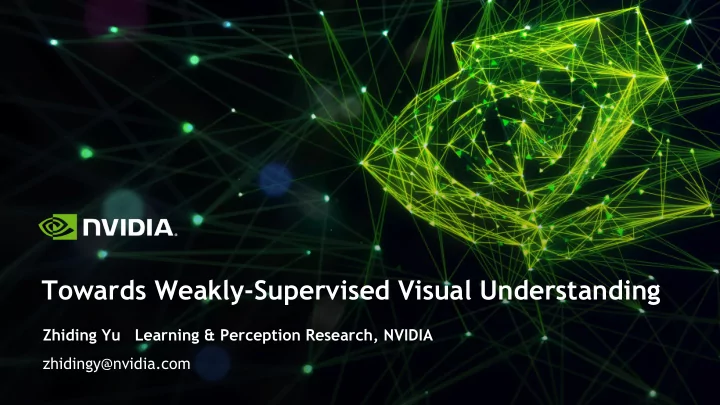

Towards Weakly-Supervised Visual Understanding Zhiding Yu Learning & Perception Research, NVIDIA zhidingy@nvidia.com
Introduction
The Benefit of Big Data and Computation Power Figure credit: Kaiming He et al., Deep Residual Learning for Image Recognition, CVPR16
Beyond Supervised Learning Reinforcement Learning (Cherry) Supervised Learning (Icing) Unsupervised Learning (Cake) “The revolution will not be supervised!” “If intelligence was a cake, unsupervised learning would be the cake, supervised learning would be the icing on the cake, and reinforcement — Alyosha Efros learning would be the cherry on the cake.” — Yann LeCun
Weakly-Supervised Learning From Research Perspective ▪ Similar to how human learns to understand the world Good support for “continuous learning” ▪ From Application Perspective Good middle ground between unsupervised learning ▪ and supervised learning ▪ Potential to accommodate labels in diverse forms Scalable to much larger amount of data ▪ Image credit: https://firstbook.org/blog/2016/03/11/ teaching-much-more-than-basic-concepts/
Weakly-Supervised Learning Inaccurate Inexact Supervision Supervision WSL Incomplete Supervision
Weakly-Supervised Learning ▪ ▪ Wrong/misaligned labels Seg/Det with cls label/bbox/point ▪ ▪ Ambiguities Multiple instance learning Inaccurate Inexact ▪ ▪ Noisy label learning Attention models Supervision Supervision WSL Eliminating the intrinsic uncertainty in WSL is the key! Self-supervision Meta-supervision Structured info ▪ Semi-supervised learning ▪ Teacher-student models Incomplete ▪ Domain adaptation Supervision Domain prior Normalization
Learning with Inaccurate Supervision 8
Category-Aware Semantic Edge Detection Original Image Perceptual Edges Semantic Edges Category-Aware Semantic Edges
Category-Aware Semantic Edge Detection Saining Xie et al., Holistically-Nested Edge Zhiding Yu et al., CASENet: Deep Category-Aware Detection , ICCV15 Semantic Edge Detection , CVPR17
Human Annotations Can Be Noisy! Image credit: Microsoft COCO: Common Objects in Context (http://cocodataset.org)
Motivations of This Work Automatic edge alignment Producing high quality sharp/crisp edges during testing
The Proposed Learning Framework Zhiding Yu et al., Simultaneous Edge Alignment and Learning , ECCV18
Learning and Optimization
Experiment: Qualitative Results (SBD) Original GT CASENet SEAL
Experiment: Qualitative Results (Cityscapes) Original GT CASENet SEAL
17
18
SBD Test Set Re-Annotation
Experiment: Quantitative Results
Experiment: Automatic Label Refinement Original GT SEAL Alignment on Cityscapes (red: before alignment, blue: after alignment)
Learning with Incomplete Supervision
Obtaining Per-Pixel Dense Labels is Hard Real application often requires model robustness over scenes with large diversity ▪ Different cities, different weather, different views Large scale annotated image data is beneficial ▪ Annotating large scale real world image dataset is expensive ▪ Cityscapes dataset: 90 minutes per image on average
Use Synthetic Data to Obtain Infinite GTs? Original image from Cityscapes Human annotated ground truth Original image from GTA5 Ground truth from game Engine
Drop of Performance Due to Domain Gaps Cityscapes images Model trained on Cityscapes Model trained on GTA5
Unsupervised Domain Adaptation
Domain Adaptation via Deep Self-Training Yang Zou*, Zhiding Yu* et al., Unsupervised Domain Adaptation for Semantic Segmentation via Class- Balanced Self-Training , ECCV18
Preliminaries and Definitions
Self-Training (ST) with Self-Paced Learning
Class-Balanced Self-Training
Self-Paced Learning Policy Design
Incorporating Spatial Priors
Experiment: GTA to Cityscapes Original Image Ground Truth Source Model CBST-SP
Experiment: GTA to Cityscapes
Learning with Inexact Supervision
Learning Instance Det/Seg with Image-Level Labels Previous Method (WSDDN) Our Proposed Method Work in progress with Zhongzheng Ren, Xiaodong Yang, Ming-Yu Liu, and Jan Kautz et al.
Conclusions and Future Works
Conclusions and Future Works Conclusions WSL methods are useful in a wide range of tasks, such as Autonomous Driving, IVA, AI City, ▪ Robotics, Annotation, Web Video Analysis, Cloud Service, Advertisements, etc. ▪ Impact from a fundamental research perspective towards achieving AGI. Future works ▪ A good WSL platform that can handle a variety of weak grounding signals and tasks. Models with better designed self-sup/meta-sup/structured info/priors/normalization. ▪ ▪ Large-scale weakly and unsupervised learning from videos. Weak grounding signal with combination to robotics and reinforcement learning. ▪
Thanks You!
Recommend
More recommend